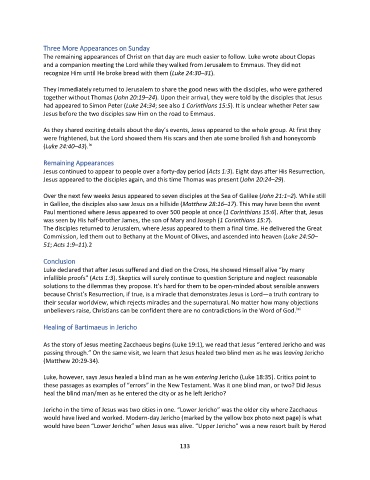Page 135 - Doctrine and History of the Preservation of the Bible revised
P. 135
Three More Appearances on Sunday
The remaining appearances of Christ on that day are much easier to follow. Luke wrote about Clopas
and a companion meeting the Lord while they walked from Jerusalem to Emmaus. They did not
recognize Him until He broke bread with them (Luke 24:30–31).
They immediately returned to Jerusalem to share the good news with the disciples, who were gathered
together without Thomas (John 20:19–24). Upon their arrival, they were told by the disciples that Jesus
had appeared to Simon Peter (Luke 24:34; see also 1 Corinthians 15:5). It is unclear whether Peter saw
Jesus before the two disciples saw Him on the road to Emmaus.
As they shared exciting details about the day’s events, Jesus appeared to the whole group. At first they
were frightened, but the Lord showed them His scars and then ate some broiled fish and honeycomb
lxi
(Luke 24:40–43).
Remaining Appearances
Jesus continued to appear to people over a forty-day period (Acts 1:3). Eight days after His Resurrection,
Jesus appeared to the disciples again, and this time Thomas was present (John 20:24–29).
Over the next few weeks Jesus appeared to seven disciples at the Sea of Galilee (John 21:1–2). While still
in Galilee, the disciples also saw Jesus on a hillside (Matthew 28:16–17). This may have been the event
Paul mentioned where Jesus appeared to over 500 people at once (1 Corinthians 15:6). After that, Jesus
was seen by His half-brother James, the son of Mary and Joseph (1 Corinthians 15:7).
The disciples returned to Jerusalem, where Jesus appeared to them a final time. He delivered the Great
Commission, led them out to Bethany at the Mount of Olives, and ascended into heaven (Luke 24:50–
51; Acts 1:9–11).2
Conclusion
Luke declared that after Jesus suffered and died on the Cross, He showed Himself alive “by many
infallible proofs” (Acts 1:3). Skeptics will surely continue to question Scripture and neglect reasonable
solutions to the dilemmas they propose. It’s hard for them to be open-minded about sensible answers
because Christ’s Resurrection, if true, is a miracle that demonstrates Jesus is Lord—a truth contrary to
their secular worldview, which rejects miracles and the supernatural. No matter how many objections
lxii
unbelievers raise, Christians can be confident there are no contradictions in the Word of God.
Healing of Bartimaeus in Jericho
As the story of Jesus meeting Zacchaeus begins (Luke 19:1), we read that Jesus “entered Jericho and was
passing through.” On the same visit, we learn that Jesus healed two blind men as he was leaving Jericho
(Matthew 20:29-34).
Luke, however, says Jesus healed a blind man as he was entering Jericho (Luke 18:35). Critics point to
these passages as examples of “errors” in the New Testament. Was it one blind man, or two? Did Jesus
heal the blind man/men as he entered the city or as he left Jericho?
Jericho in the time of Jesus was two cities in one. “Lower Jericho” was the older city where Zacchaeus
would have lived and worked. Modern-day Jericho (marked by the yellow box photo next page) is what
would have been “Lower Jericho” when Jesus was alive. “Upper Jericho” was a new resort built by Herod
133

